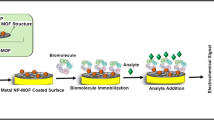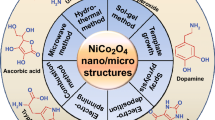Abstract
Covalent organic frameworks (COFs) are crystalline nano/microporous materials assembled from organic molecules through covalent bonds. Having various advantages such as large surface area, fully conjugated structure, and being in atom-thick dimensions makes COFs a promising candidate for numerous applications such as energy storage, electrocatalysis, and electrochemical devices. Yet, their potential for facilitating biosensor design and bioelectrochemical processes has not extensively been investigated. Therefore, in this study, we harnessed the simplicity, enhanced conductive property, and organic nature of COFs in electrochemical enzymatic biosensor design that aimed to detect superoxide radicals as a model system. Two different triazine-based COFs, CTF-1 and TRITER-1, were successfully synthesized and characterized using Fourier-transform infrared spectroscopy (FT-IR), nuclear magnetic resonance (NMR), X-ray diffraction (XRD), and transmission electron microscopy (TEM). Electrochemical studies demonstrated that CTF-1 improves the electrochemical performance of the enzymatic biosensors and is suitable for electrode design. Using the developed CTF-1-based biosensor that uses superoxide dismutase (SOD) as recognizing element, we measured the levels of superoxide anions, which are known to include in carcinogenesis process, with 0.5 nM detection limit.






Similar content being viewed by others
References
Moller K, Bein T (2013) Mesoporosity—a new dimension for zeolites. Chem Soc Rev 42:3689–3707
Stock N, Biswas S (2011) Synthesis of metal-organic frameworks (MOFs): routes to various MOF topologies, morphologies, and composites. Chem Rev 112:933–969
Zhou H-C, Long JR, Yaghi OM (2012) Introduction to metal–organic frameworks. Chem Rev 112:673–674
Guillerm V, Kim D, Eubank JF, Luebke R, Liu X, Adil K, Lah MS, Eddaoudi M (2014) A supermolecular building approach for the design and construction of metal–organic frameworks. Chem Soc Rev 43:6141–6617
Eddaoudi M, Sava DF, Eubank JF, Adila K, Guillerm V (2015) Zeolite-like metal–organic frameworks (ZMOFs): design, synthesis, and properties. Chem Soc Rev 44:228–249
Ding S-Y, Wang W (2013) Introduction to metal–organic frameworks, covalent organic frameworks (COFs): from design to applications. Chem Soc Rev 42:548–568
Waller PJ, Gándara F, Yaghi OM (2015) Chemistry of covalent organic frameworks, chemistry of covalent organic frameworks. Acc Chem Res 48:3053–3063
Sakaushi K, Antonietti M (2015) Carbon- and nitrogen-based organic frameworks. Acc Chem Res 48:1591–1600
Segura JL, Mancheno MJ, Zamora F (2016) Covalent organic frameworks based on Schiff-base chemistry: synthesis, properties and potential applications. Chem Soc Rev 45:5635–5671
Das S, Heasman P, Ben T, Qiu S (2017) Porous organic materials: strategic design and structure–function correlation. Chem Rev 117:1515–1563
Ren S, Bojdys MJ, Dawson R, Laybourn A, Khimyak YZ, Adams DJ, Cooper AI (2012) Porous, fluorescent, covalent triazine-based frameworks via room-temperature and microwave-assisted synthesis. Adv Mater 24:2357–2361
Dogru M, Bein T (2014) On the road towards electroactive covalent organic frameworks. Chem Commun 50:5531–5546
Rao MR, Fang Y, Feyter SD, Perepichka DF (2017) Conjugated covalent organic frameworks via Michael addition–elimination. J Am Chem Soc 139:2421–2427
Hao L, Ning J, Luo B, Wang B, Zhang Y, Tang Z, Yang J, Thomas A, Zhi L (2015) Structural evolution of 2D microporous covalent triazine-based framework toward the Study of high-performance supercapacitors. J Am Chem Soc 137:219–225
Khattak AM, Ghazi ZA, Liang B, Khan NA, Iqbal A, Li L, Tang Z (2016) A redox-active 2D covalent organic framework with pyridine moieties capable of faradaic energy storage. J Mater Chem A 4:16312–16317
Ling P, Lei J, Ju H (2015) Porphyrinic metal-organic framework as electrochemical probe for DNA sensing via triple-helix molecular switch. Biosens Bioelectron 71:373–379
Lu X, Wang X, Wu L, Wu L, Lei F, Gao Y, Chen J (2016) Response characteristics of bisphenols on metalorganic framework based tyrosinase nanosensor. ACS Appl Mater Interfaces 8(25):16533–16539
Deep A, Bhardwaj SK, Paul AK, Kim KH, Kumar P (2015) Surface assembly of nano-metal organic framework on amine functionalized indium tin oxide substrate for impedimetric sensing of parathion. Biosens Bioelectron 15(65):226–231
Hosseini H, Ahmar H, Dehghani A, Bagheri A, Tadjarodi A, Fakhari AR (2013) A novel electrochemical sensor based on metal-organic framework for electro-catalytic oxidation of L-cysteine. Biosens Bioelectron 15(42):426–429
Wang X, Lu X, Wu L, Chen J (2015) 3D metal-organic framework as highly efficient biosensing platform for ultrasensitive and rapid detection of bisphenol A. Biosens Bioelectron 15(65):295–301
Zhang C, Wang X, Hou M, Li X, Wu X, Ge J (2017) Immobilization on metal–organic framework engenders high sensitivity for enzymatic electrochemical detection. ACS Appl Mater Interfaces 9(16):13831–13836
Wu Y, Han J, Xue P, Xu R, Kang Y (2015) Nano metal–organic framework (NMOF)-based strategies for multiplexed microRNA detection in solution and living cancer cells. Nanoscale 7:1753–1759
Miller SE, Teplensky MH, Moghadam PZ, Fairen-Jimenez D (2016) Metal–organic frameworks as biosensors for luminescence-based detection and imaging. Interface Focus 6(4):20160027
Liao H, Ding H, Li B, Ai X, Wang C (2014) Covalent-organic frameworks: potential host materials for sulfur impregnation in lithium–sulfur batteries. J Mater Chem A 2:8854–8858
Bi B, Fang W, Li L, Wang J, Liang S, He Y, Liu M, Wu L (2015) Covalent triazine-based frameworks as visible light photocatalysts for the splitting of water. Macromol Rapid Commun 36:1799–1805
Gomes R, Bhanja P, Bhaumik A (2015) A triazine-based covalent organic polymer for efficient CO2 adsorption. Chem Commun 51:10050–10053
Chang F, Guo J, Wu G, Liu G, Zhang M, He T, Wang P, Yu P, Chen P (2015) Covalent triazine-based framework as an efficient catalyst support for ammonia decomposition. RSC Adv 5:3605–3610
Kuecken S, Schmidt J, Zhi L, Thomas A (2015) Conversion of amorphous polymer networks to covalent organic frameworks under ionothermal conditions: a facile synthesis route for covalent Triazine frameworks. J Mater Chem A 3:24422–24427
Laviron E (1979) General expression of the linear potential sweep voltammogram in the case of diffusionless electrochemical systems. J Electroanal Chem 101:19–28
Zhou Y, Ding J, Liang T, Abdel-Halim E-S, Jiang L, Zhu J-J (2016) FITC doped rattle-type silica colloidal particle-based ratiometric fluorescent sensor for biosensing and imaging of superoxide anion. ACS Appl Mater Interfaces 8:6423–6430
Tang J, Zhu X, Niu X, Liu T, Zhao H, Lan M (2015) An amperometric superoxide anion radicalbiosensor based on SOD/PtPd-PDARGO modified electrode. Talanta 137:18–24
Thandavan K, Gandhi S, Sethuraman S, Bosco J, Rayappan B, Krishnan UM (2013) A novel nano-interfaced superoxide biosensor. Sens Actuators B 176:884–892
Wang M-Q, Ye C, Bao S-J, Xu M-W, Zhang Y, Wang L, Ma X-Q, Guo J, Li C-M (2017) Nanostructured cobalt phosphates as excellent biomimetic enzymes to sensitively detect superoxide anions released from living cells. Biosens Bioelectron 87:998–1004
Penga F, Xu T, Wu F, Ma C, Liu Y, Li J, Zhao B, Mao C (2017) Novel biomimetic enzyme for sensitive detection of superoxide anions. Talanta 174:82–91
Author information
Authors and Affiliations
Corresponding author
Ethics declarations
Conflict of interest
The authors declare no conflict of interest.
Additional information
Publisher's Note
Springer Nature remains neutral with regard to jurisdictional claims in published maps and institutional affiliations.
Electronic supplementary material
Below is the link to the electronic supplementary material.
Rights and permissions
About this article
Cite this article
Yildirim, O., Derkus, B. Triazine-based 2D covalent organic frameworks improve the electrochemical performance of enzymatic biosensors. J Mater Sci 55, 3034–3044 (2020). https://doi.org/10.1007/s10853-019-04254-5
Received:
Accepted:
Published:
Issue Date:
DOI: https://doi.org/10.1007/s10853-019-04254-5




